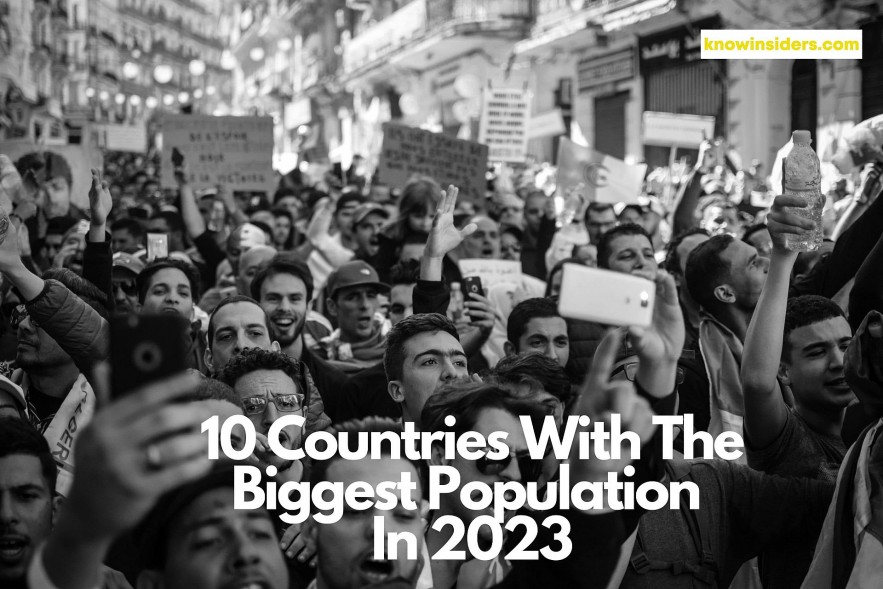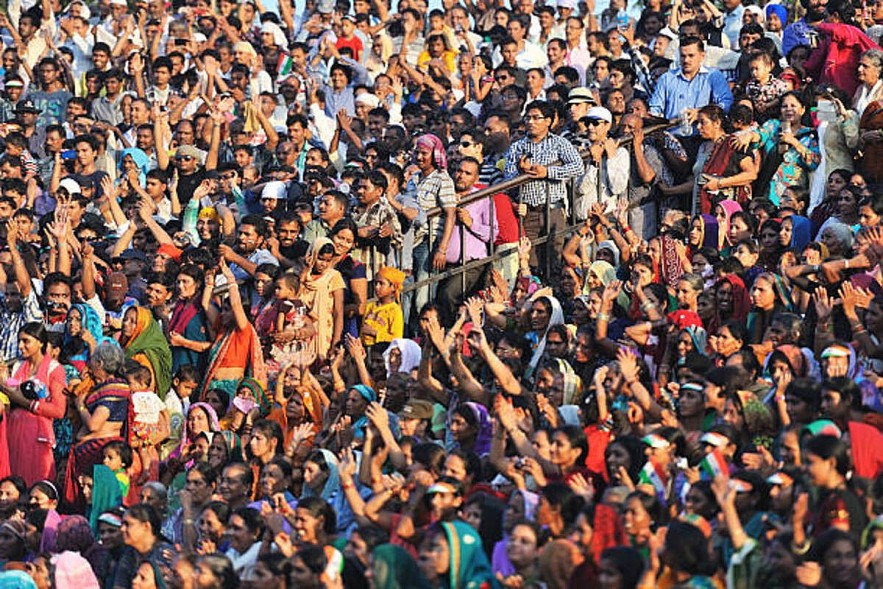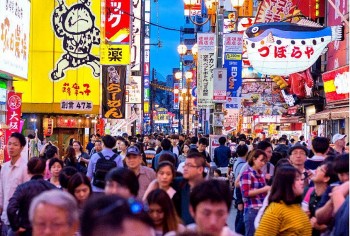Top 10 Countries with the Biggest Elderly, Urban And Rural Population
 |
| Top 10 Countries With The Biggest Population In 2023. Photo: KnowInsiders.com |
What is the world's population now?
The population of the world is currently estimated to be over eight billion, with the 8,000,000,000 mark being reached on November 15, 2022.
In retrospect, the figure seems unfathomable because only 11 years ago, there were seven billion people on Earth.
The world's two most populous nations, China and India, each with 1.4 billion inhabitants, continue to be one another.
India is soon anticipated to surpass China as the most populous nation in the world, despite China's birth rate slowing recently as a result of the government's one child only policy. In fact, it's predicted that India's population will reach 1.6 billion in 2050.
 What is the Most Populous Country in the World 2023: India to Overtake China What is the Most Populous Country in the World 2023: India to Overtake China |
Where was the world's eight billionth baby born?The symbolic choice is Damian, a newborn born in Santo Domingo, Dominican Republic's Nuestra Senora de la Altagracia maternity hospital, even though we can't be certain who the eight billionth person was. He was even photographed wearing a special outfit, and as he gets older, he will always have this honor. |
Is the world big enough for eight billion people?There is a growing case to be made that the current population will not be able to sustain itself. According to Padraig Carmody, a Geography Professor at Trinity College, the issue lies not with a lack of resources but its distribution. "We have enough resources," Carmody told Newstalk Breakfast. "If you look at some recent statistics, there's actually more obese people in the world than there is malnourished people. "So, it's a question of distribution. So, we actually have the resources to be able to feed everyone for example. "So, it's more a question of maldistribution - it's not primarily population." |
Top 10 Countries With Largest Population Aged Over 65
1.China-167.8 million people aged 65+
2.India-90.7 million
3.US-54.8 million
4.Japan-35.7 million
5.Russia-22.3 million
6.Brazil-20.4 million
7.Germany-18.1 million
8.Indonesia-17.1 million
9.France-14 million
10.Italy-13.9 million
No nation is exempt from the effects of the seismic demographic shift the world is currently experiencing.
Japan has a higher per capita population of people aged 65 and over, despite the fact that China is the country with the most elderly people overall.
In Japan, more than 28.2% of people are 65 or older, compared to nearly 12% of the population in China, according to the Population Reference Bureau.
There will be 10 billion people on the planet by 2050, up from 7.7 billion at present, and many of them will live longer. As a result, from 20 in 1980 to 58 in 2060, there will be nearly three times as many elderly people per 100 people of working age.
All OECD nations have aging populations, but there are distinct differences in the rate of aging. For instance, Japan, where one-third of the population is already over 65, holds the record for having the oldest population. The country's workforce is predicted to shrink by 8 million people by 2030, potentially creating a severe labor shortage.
Another illustration is that while South Korea's population is currently younger than average, it will age quickly and eventually have the highest old-to-young ratio among developed nations.
READ MORE: What is the Most Populous Country in the World 2023: India to Overtake China
China's Aging PopulationChina's population is aging quickly. Chinese state media claims that China is already on the verge of a "moderately aging" situation in which 20% of its population is 60 years of age or older. That number is anticipated to increase to 30% by 2035, or more than 400 million people. China also seems to be on track to roughly double its "dependency ratio" by 2100, which is the percentage of its population that is not of working age (either ages 0 to 14 or ages 65 and older), as opposed to the percentage that is (15 to 64). Even in the UN's "low variant" projection, this is accurate. According to the UN's middle-of-the-road projection, by the year 2079, there will be 101.1 times as many Chinese people dependent on others as there are in the working-age population. |
US Aging PopulationThe United States is aging. The number of people ages 65 and older rose from 19.1 million to 36.8 million between 1967 and 2006.6 Life expectancy at birth climbed from 70.5 years to 77.8 years between 1967 and 2006. |
Top 10 Countries With Biggest Urban Population
 |
| Photo Business Today |
1.China-861.3 million people living in urban areas
2.India-482 million
3.US-272.4 million
4.Brazil-185.1 million
5.Indonesia-154.9 million
6.Japan-115.5 million
7.Russia-107.7 million
8.Nigeria-107.1 million
9.Mexico-104.1 million
10.Pakistan-82.1 million
The vast majority of people in the world lived in rural areas prior to the Industrial Revolution. But as urbanization accelerated in the early 1900s, more than half of the world's population now calls cities home.
As soon as China's economic reforms started in the late 1970s, the country's urbanization really took off. China had 861 million urban residents as of 2021, or 63% of the country's total population.
With an aggregate population of 37 million, Tokyo is the largest city in the world. It is followed in size by New Delhi (29 million), Shanghai (26 million), Mexico City (22 million), and So Paulo (22 million). Cairo, Mumbai, Beijing, and Dhaka all have populations of close to 20 million today. Tokyo's population is anticipated to start declining by 2020, while Delhi is anticipated to keep growing and surpass Tokyo as the world's most populous city by 2028.
43 megacities with populations greater than 10 million are expected to exist worldwide by 2030, the majority of them located in developing regions. However, cities with fewer than 1 million residents—many of them in Asia and Africa—constitute some of the urban agglomerations that are growing the fastest. Nearly half of all urban dwellers live in much smaller communities with fewer than 500,000 residents, compared to the one in eight people who reside in 33 megacities worldwide.
Sustainable urbanization is key to successful developmentIn order to implement the 2030 Agenda for Sustainable Development, including efforts to create a new framework for urban development, it is imperative to understand the key trends in urbanization that are likely to emerge over the upcoming years. Sustainable development is becoming more and more dependent on the effective management of urban growth as the world continues to become more urbanized, particularly in low-income and lower-middle-income countries where the rate of urbanization is anticipated to be the quickest. Meeting the demands of their expanding urban populations in terms of housing, transportation, energy, and other infrastructure, as well as employment and essential services like education and healthcare, will be difficult for many nations. In order to better the lives of both urban and rural residents and to strengthen the connections between them by building on their already-existing economic, social, and environmental ties, integrated policies are required. The needs of the urban poor and other vulnerable groups for housing, education, health care, decent work, and a safe environment must be prioritized in urban growth management policies in order to ensure that the advantages of urbanization are equally shared and inclusive. |
Top 10 Countries With Biggest Rural Population
 |
| Photo Statesman |
1.India-898 million people living in rural areas
2.China-540.8 million
3.Pakistan-138.8 million
4.Indonesia-118.6 million
5.Bangladesh-101.8 million
6.Nigeria-99 million
7.Ethiopia-90 million
8.Vietnam-61 million
9.Egypt-58.6 million
10.Philippines-57.6 million
By 2050, 68% of the world's population, up from 55% today, is anticipated to reside in cities. According to projections, there could be an additional 2.5 billion people living in urban areas by 2050 as a result of urbanization, which is the gradual transition of people from rural to urban areas. Nearly 90% of this increase is expected to occur in Asia and Africa, according to a new United Nations data set released today.
The Population Division of the UN Department of Economic and Social Affairs (UN DESA) published the 2018 Revision of World Urbanization Prospects, which states that future increases in the size of the world's urban population are anticipated to be highly concentrated in a small number of countries. India, China, and Nigeria will together be responsible for 35% of the projected increase in the global urban population between 2018 and 2050. India is expected to have 416 million more urban residents by 2050, followed by China with 255 million and Nigeria with 189 million.
The number of people living in urban areas worldwide increased quickly from 751 million in 1950 to 4.2 billion in 2018. Despite having a relatively lower rate of urbanization, 54% of the world's population lives in cities, with 13% each in Europe and Africa.
With 82% of its population residing in urban areas in 2018, Northern America, Latin America and the Caribbean (81%), Europe (74%) and Oceania (68%) are the regions that are currently the most urbanized. In Asia, the rate of urbanization is currently close to 50%. In contrast, Africa still has a large rural population (43% of its people live in cities).
When comparing rural populations, many Asian and East African nations come out on top, but India easily holds the top spot with 898 million people.
According to statistics from 2021, about 65% of Indians live in rural areas. In fact, this represents a significant decline from the 1960s, when 82% of the nation's population lived in rural areas.
That's still considerably higher than in Western nations, though. For example, only 17% of Americans reside in rural areas.
 Top 9 Smallest Countries in the World By Population Top 9 Smallest Countries in the World By Population Based on the population, here is the list of the 9 smallest countries in the world. |
 What Is the Largest City in the World by Land Area and Population? What Is the Largest City in the World by Land Area and Population? Have you ever wondered which is the largest city in terms of land and population in the world today? |
 Top 25 Smallest Towns in USA by Population Today Top 25 Smallest Towns in USA by Population Today Let's discover the smallest towns (cities) in the heart of the United States - the country ranks 3rd in the world in terms of population ... |



























